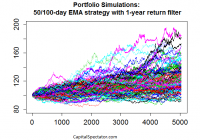Benchmarks May Have Their Uses But Gauging Portfolio Risk Is Not One Of Them
By Nick Kirrage Here on The Value Perspective, we have nothing against market indices in themselves but we do worry about how investors sometimes use them. Say you wanted to measure the relative returns on your investments over a suitably long time period, then please – benchmark away. But if you were planning to use an index as a way of gauging risk on your portfolio, here is why you should think again. People tend to see benchmarks as neutral entities and so, in some way, as an indication of safety – yet they are anything but. The classic example here – as so often – is the tech boom of the late 1990s. As technology stocks rose in value to become an ever greater part of market indices, so any ‘benchmark-aware’ funds had to buy more and more of the sector. As we know, this did not end well. Clearly, buying more tech in early 2000 as a means of reducing your risk relative to a benchmark index was a pretty flawed strategy but this is hardly a one-off example in the world of equities – or indeed in investment as a whole. In the fixed income sector, for example, index-relative global funds end up increasing their exposure to countries with the greatest amount of debt, regardless of the inherent risks. The reason we are revisiting the issue here is because of the recent decision by index provider MSCI not to include ‘A-Shares’ – those traded on China’s mainland stock exchanges of Shanghai and Shenzhen, as distinct from the ‘H-Shares’ traded on the Hong Kong exchange – within its principal global emerging markets benchmark. The last 18 months or so have seen an extraordinary bull run in Chinese equities and, while there have recently been some signs that has started to stall, China – by virtue of those H-Shares – now accounts for roughly 25% of the entire MSCI Global Emerging Markets Index. Had MSCI decided to include China’s A-Shares too, then that weighting would have jumped to around 45%. Presumably it is only a matter of time before MSCI deems all Chinese shares to be part of its emerging markets universe but, to our way of thinking, that is the rather farcical aspect of this debate – after all, regardless of whether MSCI or any other organizations reckons China to be an emerging market, it clearly is one. Where it becomes dangerous – and why we see MSCI’s decision as a near-miss (or perhaps a stay of execution) for benchmark-aware investors – is, the moment A-Shares are included in the index, these people will feel compelled to redirect yet larger quantities of money towards Chinese stocks because they apparently believe it would be a ‘risk’ to be so underweight China relative to their benchmark. But is that not perverse? It is not as if some huge new risk will have been revealed the day China’s weighting moves up from, say, 25% to 45%. Either it was always a risk to hold 25% in China or it was never one. The reality will not have changed, only some of the rules – but those rules can become hugely distorting. After all, if A-Shares had received the nod from MSCI and China now made up almost half the index, benchmark-aware investors would have had to scale back their exposures to other important emerging markets – for example, to 11% in Korea, 5.5% in Brazil and just 5% in India. This may not be quite as stark as our earlier tech boom example but it could have similarly unwanted consequences. Mind you, it could also throw up some similarly inviting possibilities for investors who prefer, as we do here on The Value Perspective, to think about risk in absolute as opposed to relative terms and for whom, in many ways, benchmark indices represent an opportunity more than they do a threat.
